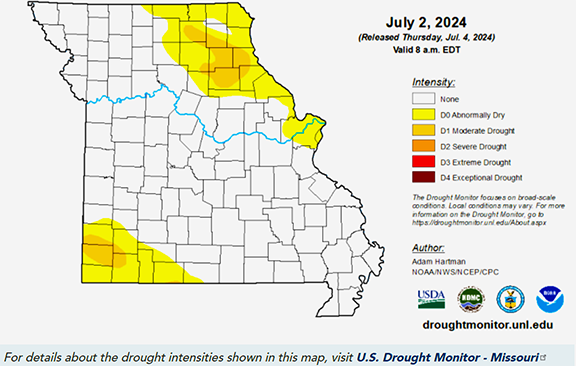JEFFERSON CITY, MO. – The Missouri Department of Natural Resources’ Drought Assessment Committee will meet at 2 p.m. Friday, July 19, in Jefferson City to continue coordinating a comprehensive state and federal response to drought conditions affecting portions of the state.

A drought alert is currently active until Sept. 1 in accordance with Governor Mike Parson’s Executive Order 24-05. Missouri has been under a drought alert continuously since May 2023. A previous drought alert was also active from July 2022 to March 2023.
The meeting will be held in the LaCharrette and Nightingale conference rooms at the Lewis and Clark State Office Building, located at 1101 N. Riverside Drive in Jefferson City. The meeting is open to the public and will also be livestreamed via Webex at http://stateofmo.webex.com/stateofmo/j.php….
The Drought Assessment Committee is composed of representatives from state and federal partner agencies who provide information, recommendations and coordination to mitigate impacts of the drought. Executive Order 24-05 declared a drought alert for Missouri counties that are in moderate, severe or extreme drought. Nearly all of Missouri has experienced at least abnormally dry conditions over the past year.
Residents are encouraged to assist local, state and national decision makers better understand drought conditions in their area by submitting a survey form via the Condition Monitoring Observer Reports service at http://droughtimpacts.unl.edu/…/ConditionMonitoringObse….
Updated drought information, including a link to the U.S. Drought Monitor map of Missouri, is available at www.dnr.mo.gov/drought
What is a drought?
The amount of precipitation in a particular area varies from year to year, but over a period of years the average amount is fairly constant. A drought is a period of drier-than-normal conditions that results in water-related problems and other issues. When little or no rain falls, soils can dry out, plants can die and livestock can suffer. When dry weather persists, stream and river flows can decline, water levels in lakes and reservoirs can fall and water in wells and aquifers can decline. Drought can have a serious impact on health, agriculture, economies, energy and the environment.
Droughts can develop quickly or gradually over several weeks, months or even years, and worsened with extreme heat or wind. A drought can end just as quickly or gradually as it began, but more commonly persist for months. A single rainstorm may provide temporary relief, but its impact is short term. Thunderstorms often produce large amounts of rain in a very short time, causing the rain to run off into streams rather than soak into the ground. Several soaking rains may be required to recharge groundwater and break a drought.
Reporting Drought Conditions
Reports and photographs are essential tools used to assess drought conditions. The department encourages the public to submit information and photographs about conditions in their area in order to help local, state and national decision-makers assess drought conditions and impacts in Missouri. If you would like to submit drought-related conditions and impacts for your area, please fill out the survey form at Condition Monitoring Observer Reports (CMOR)*
Tips and best practices for using CMOR, including how to download and use its field app, can be found in the CMOR troubleshooting guide. A MoDNR video training, presentation and overview of how CMOR reports help MoDNR achieve its goals are also available. Please note, those uploading photos to CMOR using newer iPhones will need to change their photo format settings to “most compatible” to successfully add images. Users also don’t need a user account to submit CMOR reports, and can “continue without logging in” to proceed.
*The survey is a nationwide service developed by the National Drought Mitigation Center, based at the University of Nebraska, in partnership with the National Integrated Drought Information System and the U.S. Department of Agriculture.
